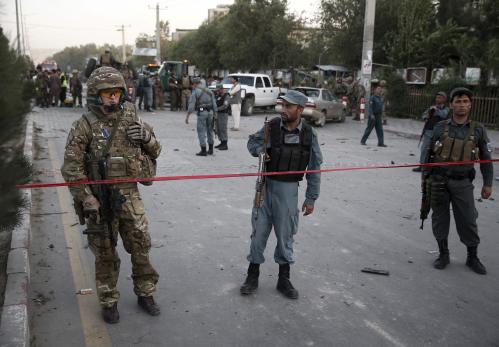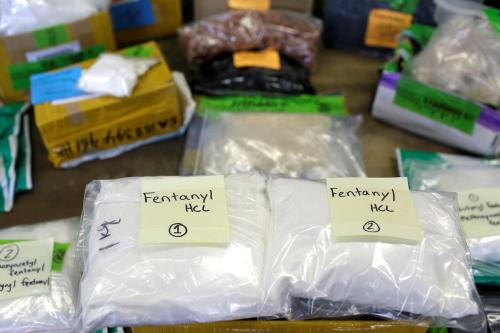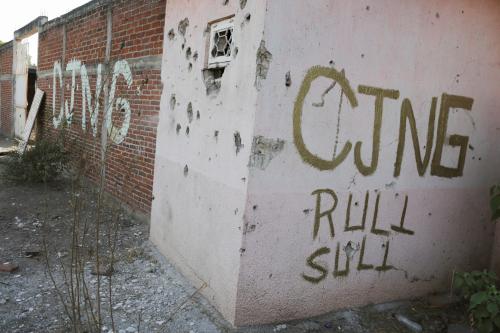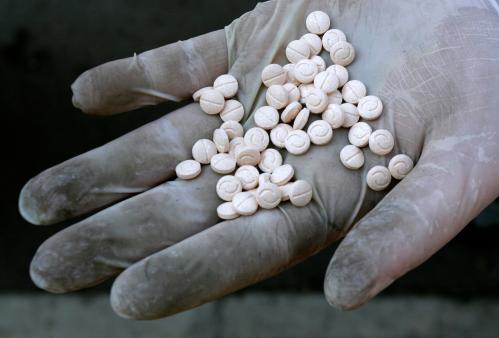This piece is part of a series titled “Nonstate armed actors and illicit economies: What the Biden administration needs to know,” from Brookings’s Initiative on Nonstate Armed Actors.
How to address the ongoing threat of illegal drug use in the United States remains a persistent challenge. The activities of increasingly sophisticated transnational criminal organizations (TCOs) exacerbate that challenge for the whole of the Western Hemisphere. The incoming Biden administration should be especially wary of the likely inevitable growth of fentanyl shipment through maritime areas and the potential for such organizations to use technology to engage in “gray zone”-like activities, which could make their trafficking operations even more effective. The new administration should likewise prioritize and bolster counter-TCO intelligence support, consider advancing the use of U.S. cyber tools, and enhance the capabilities and capacity of the U.S. Coast Guard to help mitigate that threat.
Drug trafficking in the Western Hemisphere
It is no secret that the United States has a nearly unquenchable appetite for illegal drugs. This appetite drives demand, which TCOs in the Western Hemisphere happily meet. In doing so over the years, these TCOs have become increasingly wealthy and powerful throughout the Western Hemisphere — so much so that in some regions of Mexico and elsewhere in Latin America, they compete (well) for primacy with governments.
In Latin America, the TCOs often resort to extraordinary violence to address challenges by rivals, compel behavior of the local populace, and resist attempts by the local government to check their actions. This violence severely destabilizes the entire hemisphere. Closer to home, TCO violence is a significant contributor to the out-migration that has driven the consistently large numbers of migrants arriving at the United States southern border. Indeed, from October to December 2020, U.S. Customs and Border Protection (CBP) and its Border Patrol interdicted an average of 72,233 migrants at the southwest border, which translates to 1.6 migrants every minute. Most come from the Northern Triangle countries of El Salvador, Guatemala, and Honduras, although of late, relatively large numbers of Mexican nationals are being interdicted trying to cross the U.S. border.
The illegal drug trade provides a vast source of funding for the TCOs. This funding is augmented by illicit gains derived from corruption, shake downs, and “protection” rackets; human trafficking; and the smuggling of other contraband such as illegal wildlife. But trafficking in illegal narcotics provides the bulk of funding. Leaving aside for a moment the increased border control measures associated with the COVID-19 pandemic, this trafficking typically occurs across two main vectors: the land border and the maritime border. That’s not to say that TCOs don’t engage in drug shipments via mail or through air corridors, commercial or otherwise, but the majority of drug trafficking activity into the United States occurs across the land border and from the sea.
Land border
CBP, principally its Office of Field Operations, is the lead agency for United States border security issues, both at and between the ports of entry. In Fiscal Year 2020, CBP seized over 42,645 pounds of cocaine, 5,222 pounds of heroin, 324,973 pounds of marijuana, 156,901 pounds of methamphetamine, and 3,967 pounds of fentanyl. The fentanyl seizures, while the smallest in total, are perhaps the most troubling given the deadly potency of that particular drug. Moreover, fentanyl seizures have consistently increased in size over the last five years, and recent reports indicate huge increases of fentanyl seized by Mexican authorities on their side of the border.
Most of CBP’s drug seizures typically occur at ports of entry and are detected by CBP inspectors through the use of intelligence cueing, technological means, dogs, and sometimes just through good old-fashioned, well-honed observation and inquiry. TCOs ship their wares to the land border hidden in tractor trailer trucks, cars, and in some cases, people. In addition to using these same means between ports of entry, TCOs also breach existing border barriers by using tunnels and have increasingly employed drones to move shipments of drugs into the United States, amongst other purposes.
Maritime environment
Drug cartels and TCOs have a long history of using maritime means to attempt to bring drugs into the United States. They include:
- Secreting contraband aboard containers or hidden within the expanses of huge commercial vessels;
- Using secret compartments on smaller freighters;
- Employing small, difficult-to-detect “go fast” vessels intended to avoid and then evade interdiction;
- Fielding run-of-the-mill pleasure craft and fishing vessels like traditional Mexican lanchas, as well as purpose built pangas intended to blend in with legitimate traffic; and
- Deploying highly capable self-propelled semi-submersible vessels that have become more sophisticated by the year.
The Department of Defense (DoD) is the designated lead U.S. government agency for maritime counter-drug detection and monitoring. To execute this mission, it teams with a whole host of other departments and agencies, like the State Department; the Department of Justice and its components, the Drug Enforcement Administration and the Federal Bureau of Investigation; CBP (and specifically its Office of Air and Marine); Immigration and Customs Enforcement/Homeland Security Investigations; and importantly, the U.S. Coast Guard. This coordination is largely executed though the Joint Interagency Task Force (JIATF) South and JIATF West, overseen by the DoD’s Southern Command (SOUTHCOM) and Indo-Pacific Command (PACOM), respectively.
The DoD’s partnership with the Coast Guard is particularly important for several reasons. First, the Coast Guard is unique amongst federal agencies because it is at all times both a military armed force and law enforcement agency. This inherent, full-time duality allows for maximum operational flexibility when conducting independent interdiction operations or using Coast Guard deployable, specialized forces aboard DoD and partner nation platforms. The Coast Guard’s additional status as a member of the intelligence community — as well as a regulatory agency that provides oversight over any vessel in which the United States may exert jurisdiction, and any activity that occurs in waters (including seaports) where the United States may exert jurisdiction — make it a powerful tool to combat the maritime drug trafficking activities of TCOs. For example, on December 16, 2020, the Coast Guard, working in concert with partner agencies and the United Kingdom, landed for destruction or use as evidence in criminal prosecutions more than 23,000 pounds of interdicted cocaine and nearly 8,800 pounds of interdicted marijuana worth more than $411.3 million. In fact, from 2015 to 2019, “Coast Guard cutters and aircraft have removed more than 871 metric tons of high-purity cocaine from at sea, with a wholesale value of approximately $26 billion.” This is significantly more product than what is typically intercepted at the land border, and even more so considering it is often uncut product when interdicted at sea.
Next, the Coast Guard has made highly effective use of 34 bilateral agreements with partner nations throughout the region. These agreements vary in scope of authority, but when taken as a whole, they facilitate operations, interdictions, and ultimately prosecutions both in the United States and in partner nations against TCO activities across the entire maritime drug transit zone. Indeed, the success of this network of bilateral agreements in spurring cooperation between like-minded states to deal with drug traffickers in the Caribbean and Eastern Pacific has provided a useful model in the Western Pacific for countering China’s ever-growing malign regional maritime ambitions, as well as globally to address the threat of illegal, unreported, and unregulated fishing.
Issues to watch
The TCOs of 2021 are highly incredibly savvy actors who operate with real reach and power. They have made great use of today’s cutting-edge technology to facilitate their activity and constantly innovate. This means that to effectively deal with them, the United States under the Biden administration should pay as much heed to cyber and economic tools as it does to interdictor ships, boats, and aircraft. Indeed, the Department of Defense already has relatively broad statutory authority and presidential policy direction to engage in certain cyber operations. Those may, when combined with the Coast Guard’s existing authority, create additional opportunities to disrupt TCO operations by better “defending forward” — with, of course, the appropriate prioritization and direction from on high. A new Biden administration should also look for new ways to increase economic pressure on TCOs with perhaps a specific focus toward better addressing TCO’s use of digital currency that helps fuel their operations.
Several dynamics may, however, make U.S. counter-TCO operations more challenging. First is the high likelihood of widespread maritime fentanyl shipment. While data does not yet indicate that significant amounts of fentanyl are moving through maritime routes directly into the United States, this trend is growing more and more likely given the U.S. demand, the growth of fentanyl introduction and interdiction within Mexico, and the profit dynamics inherent at the intersection of small but meaningful quantities and big/fast/hard-to-catch vessels. This is a wicked problem that is not easily solved, beyond increasing the quantity and fidelity of intelligence to support interdiction operations. Doing so is a must.
The next dynamic is an apparent chilling of Mexico’s willingness to cooperate with U.S. law enforcement. Further, despite several significant efforts by the Trump administration to bring an end to Nicolás Maduro’s reign in Venezuela, that country remains a significant safe-haven to TCOs and their operations throughout the hemisphere. The Biden administration must maintain, and where possible advance, existing levels of cooperation with nations like Colombia, Costa Rica, and Panama. It must also come up with a viable strategy to address the challenges posed by the governments of Mexico and Venezuela if the Biden administration intends to gain ground on the supply-side of TCO-driven drug trafficking.
There is also some risk that TCOs become even more violent or bold in executing their operations. The conventional wisdom is that while TCO actors often get “chalk on their toes,” they’re apparently quite cognizant of the line that would provoke a more aggressive U.S. response; thus, often, but not always, they throttle their acts of violence where it directly affects Americans. But consider how the United States’ two main state rivals on the international plane, China and Russia, have so effectively used “gray-zone” tactics to achieve their strategic ends without crossing the line that would draw an armed response from the United States. In the context of TCOs, the gray zone could manifest in a number of different ways: for example, a difficult-to-attribute cyber-attack on a cruise ship in the deep Caribbean, drawing resources away from interdiction efforts, or the use of drone swarms at the land border to overwhelm resources there.
Finally, with respect to the Coast Guard, it is quite likely that at least four years of a Biden administration will result in an increased demand signal for Coast Guard resources. The Coast Guard’s unique authorities, capabilities, and competencies that allow it to thrive in the sweet spot between DoD-delivered lethality and Department of State-focused diplomacy make it an attractive tool of national power, especially in the Western Pacific and the Arctic. But there is only so much Coast Guard to go around, especially when considering the scope of Coast Guard missions beyond those even addressed in this article. If the Coast Guard is going to be the go-to solution for challenges in the maritime environment, it’s long past time for more Coast Guard. And more means both quantity, and — with respect to technologically based-solutions and capabilities, especially those that are cyber-based — quality. This will mean appropriate budget support, that must be driven by the idea that (“great” power rivalry notwithstanding) national security in the 21st century is a broader subject than traditional conceptions of defense. Effectively countering Western Hemisphere’s TCOs fits squarely within that idea.
The views expressed are the author’s alone and do not reflect the official policy or position of the United States Coast Guard, U.S. Department of Defense, U.S. Department of Homeland Security, or the U.S. Government.










Commentary
The wicked problem of drug trafficking in the Western Hemisphere
What the Biden administration can do
January 15, 2021